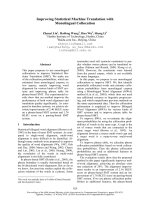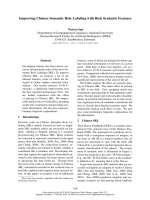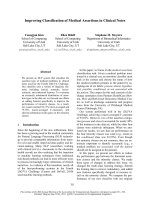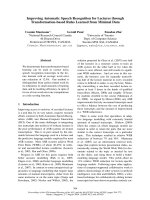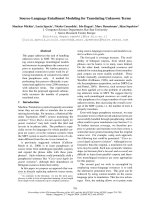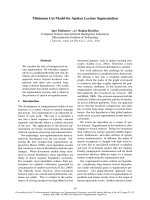Báo cáo khoa học: "Improving Language Model Size Reduction using Better Pruning Criteria" pptx
Bạn đang xem bản rút gọn của tài liệu. Xem và tải ngay bản đầy đủ của tài liệu tại đây (236.5 KB, 7 trang )
Improving Language Model Size Reduction using Better Pruning
Criteria
Jianfeng Gao
Microsoft Research, Asia
Beijing, 100080, China
Min Zhang
1
State Key Lab of Intelligent Tech & Sys.
Computer Science & Technology Dept.
Tsinghua University, China
1
This work was done while Zhang was working at Microsoft Research Asia as a visiting student.
Abstract
Reducing language model (LM) size is a
critical issue when applying a LM to
realistic applications which have memory
constraints. In this paper, three measures
are studied for the purpose of LM
pruning. They are probability, rank, and
entropy. We evaluated the performance of
the three pruning criteria in a real
application of Chinese text input in terms
of character error rate (CER). We first
present an empirical comparison, showing
that rank performs the best in most cases.
We also show that the high-performance
of rank lies in its strong correlation with
error rate. We then present a novel
method of combining two criteria in
model pruning. Experimental results
show that the combined criterion
consistently leads to smaller models than
the models pruned using either of the
criteria separately, at the same CER.
1 Introduction
Backoff n-gram models for applications such as
large vocabulary speech recognition are typically
trained on very large text corpora. An
uncompressed LM is usually too large for practical
use since all realistic applications have memory
constraints. Therefore, LM pruning techniques are
used to produce the smallest model while keeping
the performance loss as small as possible.
Research on backoff n-gram model pruning has
been focused on the development of the pruning
criterion, which is used to estimate the performance
loss of the pruned model. The traditional count
cutoff method (Jelinek, 1990) used a pruning
criterion based on absolute frequency while recent
research has shown that better pruning criteria can
be developed based on more sophisticated measures
such as perplexity.
In this paper, we study three measures for
pruning backoff n-gram models. They are
probability, rank and entropy. We evaluated the
performance of the three pruning criteria in a real
application of Chinese text input (Gao et al., 2002)
through CER. We first present an empirical
comparison, showing that rank performs the best in
most cases. We also show that the high-performance
of rank lies in its strong correlation with error rate.
We then present a novel method of combining two
pruning criteria in model pruning. Our results show
that the combined criterion consistently leads to
smaller models than the models pruned using either
of the criteria separately. In particular, the
combination of rank and entropy achieves the
smallest models at a given CER.
The rest of the paper is structured as follows:
Section 2 discusses briefly the related work on
backoff n-gram pruning. Section 3 describes in
detail several pruning criteria. Section 4 presents an
empirical comparison of pruning criteria using a
Chinese text input system. Section 5 proposes our
method of combining two criteria in model pruning.
Section 6 presents conclusions and our future work.
2 Related Work
N-gram models predict the next word given the
previous n-1 words by estimating the conditional
probability P(w
n
|w
1
…w
n-1
). In practice, n is usually
set to 2 (bigram), or 3 (trigram). For simplicity, we
restrict our discussion to bigrams P(w
n
| w
n-1
), but our
approaches can be extended to any n-gram.
The bigram probabilities are estimated from the
training data by maximum likelihood estimation
(MLE). However, the intrinsic problem of MLE is
Computational Linguistics (ACL), Philadelphia, July 2002, pp. 176-182.
Proceedings of the 40th Annual Meeting of the Association for
that of data sparseness: MLE leads to zero-value
probabilities for unseen bigrams. To deal with this
problem, Katz (1987) proposed a backoff scheme.
He estimates the probability of an unseen bigram by
utilizing unigram estimates as follows
>
=
−
−−
−
otherwisewPw
wwcwwP
wwP
ii
iiiid
ii
)()(
0),()|(
)|(
1
11
1
α
,
(1)
where c(w
i-1
w
i
) is the frequency of word pair (w
i-1
w
i
)
in the training data, P
d
represents the Good-Turing
discounted estimate for seen word pairs, and
α
(w
i-1
)
is a normalization factor.
Due to the memory limitation in realistic
applications, only a finite set of word pairs have
conditional probability P(w
i
|w
i-1
) explicitly
represented in the model. The remaining word pairs
are assigned a probability by backoff (i.e. unigram
estimates). The goal of bigram pruning is to remove
uncommon explicit bigram estimates P(w
i
|w
i-1
) from
the model to reduce the number of parameters while
minimizing the performance loss.
The research on backoff n-gram model pruning
can be formulated as the definition of the pruning
criterion, which is used to estimate the performance
loss of the pruned model. Given the pruning
criterion, a simple thresholding algorithm for
pruning bigram models can be described as follows:
1. Select a threshold
θ
.
2. Compute the performance loss due to
pruning each bigram individually using the
pruning criterion.
3. Remove all bigrams with performance loss
less than
θ
.
4. Re-compute backoff weights.
Figure 1: Thresholding algorithm for bigram
pruning
The algorithm in Figure 1 together with several
pruning criteria has been studied previously
(Seymore and Rosenfeld, 1996; Stolcke, 1998; Gao
and Lee, 2000; etc). A comparative study of these
techniques is presented in (Goodman and Gao,
2000).
In this paper, three pruning criteria will be
studied: probability, rank, and entropy. Probability
serves as the baseline pruning criterion. It is derived
from perplexity which has been widely used as a LM
evaluation measure. Rank and entropy have been
previously used as a metric for LM evaluation in
(Clarkson and Robinson, 2001). In the current paper,
these two measures will be studied for the purpose of
backoff n-gram model pruning. In the next section,
we will describe how pruning criteria are developed
using these two measures.
3 Pruning Criteria
In this section, we describe the three pruning criteria
we evaluated. They are derived from LM evaluation
measures including perplexity, rank, and entropy.
The goal of the pruning criterion is to estimate the
performance loss due to pruning each bigram
individually. Therefore, we represent the pruning
criterion as a loss function, denoted by LF below.
3.1 Probability
The probability pruning criterion is derived from
perplexity. The perplexity is defined as
∑
=
=
−
−
N
i
ii
wwP
N
P
P
1
1
)|(log
1
2
(2)
where N is the size of the test data. The perplexity
can be roughly interpreted as the expected branching
factor of the test document when presented to the
LM. It is expected that lower perplexities are
correlated with lower error rates.
The method of pruning bigram models using
probability can be described as follows: all bigrams
that change perplexity by less than a threshold are
removed from the model. In this study, we assume
that the change in model perplexity of the LM can be
expressed in terms of a weighted difference of the
log probability estimate before and after pruning a
bigram. The loss function of probability LF
probability
,
is then defined as
)]|(log)|(')[log(
111 −−−
−−
iiiiii
wwPwwPwwP
,
(3)
where P(.|.) denotes the conditional probabilities
assigned by the original model, P’(.|.) denotes the
probabilities in the pruned model, and P(w
i-1
w
i
) is a
smoothed probability estimate in the original model.
We notice that LF
probability
of Equation (3) is very
similar to that proposed by Seymore and Rosenfeld
(1996), where the loss function is
)]|(log)|(')[log(
111 −−−
−
−
iiiiii
wwPwwPwwN
.
Here N(w
i-1
w
i
) is the discounted frequency that
bigram w
i-1
w
i
was observed in training. N(w
i-1
w
i
) is
conceptually identical to P(w
i-1
w
i
) in Equation (3).
From Equations (2) and (3), we can see that lower
LF
probability
is strongly correlated with lower
perplexity. However, we found that LF
probability
is
suboptimal as a pruning criterion, evaluated on CER
in our experiments. We assume that it is largely due
to the deficiency of perplexity as a LM performance
measure.
Although perplexity is widely used due to its
simplicity and efficiency, recent researches show
that its correlation with error rate is not as strong as
once thought. Clarkson and Robinson (2001)
analyzed the reason behind it and concluded that the
calculation of perplexity is based solely on the
probabilities of words contained within the test text,
so it disregards the probabilities of alternative
words, which will be competing with the correct
word (referred to as target word below) within the
decoder (e.g. in a speech recognition system).
Therefore, they used other measures such as rank
and entropy for LM evaluation. These measures are
based on the probability distribution over the whole
vocabulary. That is, if the test text is w
1
n
, then
perplexity is based on the values of P(w
i
|w
i-1
), and
the new measures will be based on the values of
P(w|w
i-1
) for all w in the vocabulary. Since these
measures take into account the probability
distribution over all competing words (including the
target word) within the decoder, they are, hopefully,
better correlated with error rate, and expected to
evaluate LMs more precisely than perplexity.
3.2 Rank
The rank of the target word w is defined as the
word’s position in an ordered list of the bigram
probabilities P(w|w
i-1
) where w ∈ V, and V is the
vocabulary. Thus the most likely word (within the
decoder at a certain time point) has the rank of one,
and the least likely has rank |V|, where |V| is the
vocabulary size.
We propose to use rank for pruning as follows: all
bigrams that change rank by less than a threshold
after pruning are removed from the model. The
corresponding loss function LF
rank
is defined as
∑
−
−−−
−+
′
1
)}|(log])|(){log[(
111
ii
ww
iiiiii
wwRkwwRwwp
(4)
where R(.|.) denotes the rank of the observed bigram
P(w
i
|w
i-1
) in the list of bigram probabilities P(w|w
i-1
)
where w
∈
V, before pruning, R’(.|.) is the new rank
of it after pruning, and the summation is over all
word pairs (w
i-1
w
i
). k is a constant to assure that
0)|(log])|(log[
11
≠−+
′
−− iiii
wwRkwwR
. k is set to
0.1 in our experiments.
3.3 Entropy
Given a bigram model, the entropy H of the
probability distribution over the vocabulary V is
generally given by
∑
−=
=
V
j
ijiji
wwPwwPwH
1
)|(log)|()(
.
We propose to use entropy for pruning as follows:
all bigrams that change entropy by less than a
threshold after pruning are removed from the model.
The corresponding loss function LF
entropy
is defined
as
∑
−
′
−
=
−−
N
i
ii
wHwH
N
1
11
))()((
1
(5)
where H is the entropy before pruning given history
w
i-1
, H’ is the new entropy after pruning, and N is the
size of the test data.
The entropy-based pruning is conceptually
similar to the pruning method proposed in (Stolcke,
1998). Stolcke used the Kullback-Leibler divergence
between the pruned and un-pruned model
probability distribution in a given context over the
entire vocabulary. In particular, the increase in
relative entropy from pruning a bigram is computed
by
∑
−
−−−
−−
ii
ww
iiiiii
wwPwwPwwP
1
)]|(log)|(')[log(
111
,
where the summation is over all word pairs (w
i-1
w
i
).
4 Empirical Comparison
We evaluated the pruning criteria introduced in the
previous section on a realistic application, Chinese
text input. In this application, a string of Pinyin
(phonetic alphabet) is converted into Chinese
characters, which is the standard way of inputting
text on Chinese computers. This is a similar problem
to speech recognition except that it does not include
acoustic ambiguity. We measure performance in
terms of character error rate (CER), which is the
number of characters wrongly converted from the
Pinyin string divided by the number of characters in
the correct transcript. The role of the language
model is, for all possible word strings that match the
typed Pinyin string, to select the word string with the
highest language model probability.
The training data we used is a balanced corpus of
approximately 26 million characters from various
domains of text such as newspapers, novels,
manuals, etc. The test data consists of half a million
characters that have been proofread and balanced
among domain, style and time.
The back-off bigram models we generated in this
study are character-based models. That is, the
training and test corpora are not word-segmented.
As a result, the lexicon we used contains 7871 single
Chinese characters only. While word-based n-gram
models are widely applied, we used character-based
models for two reasons. First, pilot experiments
show that the results of word-based and
character-based models are qualitatively very
similar. More importantly, because we need to build
a very large number of models in our experiments as
shown below, character-based models are much
more efficient, both for training and for decoding.
We used the absolute discount smoothing method
for model training.
None of the pruning techniques we consider are
loss-less. Therefore, whenever we compare pruning
criteria, we do so by comparing the size reduction of
the pruning criteria at the same CER.
Figure 2 shows how the CER varies with the
bigram numbers in the models. For comparison, we
also include in Figure 2 the results using count cutoff
pruning. We can see that CER decreases as we keep
more and more bigrams in the model. A steeper
curve indicates a better pruning criterion.
The main result to notice here is that the
rank-based pruning achieves consistently the best
performance among all of them over a wide range of
CER values, producing models that are at 55-85% of
the size of the probability-based pruned models with
the same CER. An example of the detailed
comparison results is shown in Table 1, where the
CER is 13.8% and the value of cutoff is 1. The last
column of Table 1 shows the relative model sizes
with respect to the probability-based pruned model
with the CER 13.8%.
Another interesting result is the good
performance of count cutoff, which is almost
overlapping with probability-based pruning at larger
model sizes
2
. The entropy-based pruning
unfortunately, achieved the worst performance.
13 . 6
13 . 7
13 . 8
13 . 9
14 . 0
14 . 1
3.E+05 4.E+05 5.E+05 6.E+05 7.E+05 8.E+05 9.E+05
# of bigrams in the model
average error rate
rank
prob
entropy
count cutof
f
Figure 2: Comparison of pruning criteria
Table 1: LM size comparison at CER 13.8%
criterion # of bigram size (MB) % of prob
probability
774483
6.1 100.0%
cutoff (=1)
707088
5.6 91.8%
entropy
1167699
9.3 152.5%
rank 512339 4.1 67.2%
2
The result is consistent with that reported in (Goodman
and Gao, 2000), where an explanation was offered.
We assume that the superior performance of
rank-based pruning lies in the fact that rank (acting
as a LM evaluation measure) has better correlation
with CER. Clarkson and Robinson (2001) estimated
the correlation between LM evaluation measures
and word error rate in a speech recognition system.
The related part of their results to our study are
shown in Table 2, where r is the Pearson
product-moment correlation coefficient, r
s
is the
Spearman rank-order correlation coefficient, and T
is the Kendall rank-order correlation coefficient.
Table 2: Correlation of LM evaluation measures
with word error rates (Clarkson and Robinson,
2001)
r r
s
T
Mean log rank 0.967 0.957 0.846
Perplexity 0.955 0.955 0.840
Mean entropy -0.799 -0.792 -0.602
Table 2 indicates that the mean log rank (i.e.
related to the pruning criterion of rank we used) has
the best correlation with word error rate, followed by
the perplexity (i.e. related to the pruning criterion of
probability we used) and the mean entropy (i.e.
related to the pruning criterion of entropy we used),
which support our test results. We can conclude that
the LM evaluation measures which are better
correlated with error rate lead to better pruning
criteria.
5 Combining Two Criteria
We now investigate methods of combining pruning
criteria described above. We begin by examining the
overlap of the bigrams pruned by two different
criteria to investigate which might usefully be
combined. Then the thresholding pruning algorithm
described in Figure 1 is modified so as to make use
of two pruning criteria simultaneously. The problem
here is how to find the optimal settings of the
pruning threshold pair (each for one pruning
criterion) for different model sizes. We show how an
optimal function which defines the optimal settings
of the threshold pairs is efficiently established using
our techniques.
5.1 Overlap
From the abovementioned three pruning criteria, we
investigated the overlap of the bigrams pruned by a
pair of criteria. There are three criteria pairs. The
overlap results are shown in Figure 3.
We can see that the percentage of the number of
bigrams pruned by both criteria seems to increase as
the model size decreases, but all criterion-pairs have
overlaps much lower than 100%. In particular, we
find that the average overlap between probability
and entropy is approximately 71%, which is the
biggest among the three pairs. The pruning method
based on the criteria of rank and entropy has the
smallest average overlap of 63.6%. The results
suggest that we might be able to obtain
improvements by combining these two criteria for
bigram pruning since the information provided by
these criteria is, in some sense, complementary.
0.E+00
2.E+05
4.E+05
6.E+05
8.E+05
1.E+06
0.E+00 2.E+05 4.E+05 6.E+05 8.E+05 1.E+06
# of pruned bigrams
# of overlaped bigrams
prob+rank
prob+entropy
rank+entropy
100% overlap
Figure 3: Overlap of selected bigrams between
criterion pairs
5.2 Pruning by two criteria
In order to prune a bigram model based on two
criteria simultaneously, we modified the
thresholding pruning algorithm described in Figure
1. Let lf
i
be the value of the performance loss
estimated by the loss function LF
i
,
θ
i
be the
threshold defined by the pruning criterion C
i
. The
modified thresholding pruning algorithm can be
described as follows:
1. Select a setting of threshold pair (
θ
1
θ
2
)
2. Compute the values of performance loss lf
1
and lf
2
due to pruning each bigram
individually using the two pruning criteria
C
1
and C
2
, respectively.
3. Remove all bigrams with performance loss
lf
1
less than
θ
1
, and lf
2
less than
θ
2
.
4. Re-compute backoff weights.
Figure 4: Modified thresholding algorithm for
bigram pruning
Now, the remaining problem is how to find the
optimal settings of the pruning threshold pair for
different model sizes. This seems to be a very
tedious task since for each model size, a large
number of settings (
θ
1
θ
2
) have to be tried for finding
the optimal ones. Therefore, we convert the problem
to the following one: How to find an optimal
function
θ
2
=f(
θ
1
) by which the optimal threshold
θ
2
is defined for each threshold
θ
1
. The function can be
learned by pilot experiments described below. Given
two thresholds
θ
1
and
θ
2
of pruning criteria C
1
and
C
2
, we try a large number of values of
θ
1
,
θ
2
, and
build a large number of models pruned using the
algorithm described in Figure 4. For each model
size, we find an optimal setting of the threshold
setting (
θ
1
θ
2
) which results in a pruned model with
the lowest CER. Finally, all these optimal threshold
settings serve as the sample data, from which the
optimal function can be learned. We found that in
pilot experiments, a relatively small set of sample
settings is enough to generate the function which is
close enough to the optimal one. This allows us to
relatively quickly search through what would
otherwise be an overwhelmingly large search space.
5.3 Results
We used the same training data described in Section
4 for bigram model training. We divided the test set
described in Section 4 into two non-overlapped
subsets. We performed testing on one subset
containing 80% of the test set. We performed
optimal function learning using the remaining 20%
of the test set (referred to as held-out data below).
Take the combination of rank and entropy as an
example. An uncompressed bigram model was first
built using all training data. We then built a very
large number of pruned bigram models using
different threshold setting (
θ
rank
θ
entropy
), where the
values
θ
rank
,
θ
entropy
∈
[3E-12, 3E-6]. By evaluating
pruned models on the held-out data, optimal settings
can be found. Some sample settings are shown in
Table 3.
Table 3: Sample optimal parameter settings for
combination of criteria based on rank and entropy
# bigrams
θ
rank
θ
entropy
137987 8.00E-07 8.00E-09
196809 3.00E-07 8.00E-09
200294 3.00E-07 5.00E-09
274434 3.00E-07 5.00E-10
304619 8.00E-08 8.00E-09
394300 5.00E-08 3.00E-10
443695 3.00E-08 3.00E-10
570907 8.00E-09 3.00E-09
669051 5.00E-09 5.00E-10
890664 5.00E-11 3.00E-10
892214 5.00E-12 3.00E-10
892257 3.00E-12 3.00E-10
In experiments, we found that a linear regression
model of Equation (6) is powerful enough to learn a
function which is close enough to the optimal one.
21
)log()log(
αθαθ
+×=
rankentropy
(6)
Here α
1
and α
2
are coefficients estimated from the
sample settings. Optimal functions of the other two
threshold-pair settings (
θ
rank
θ
probability
) and (
θ
probability
θ
entropy
) are obtained similarly. They are
shown in Table 4.
Table 4. Optimal functions
5.6)log(3.0)log( +×=
rankentropy
θ
θ
2.6)log( =
yprobabilit
θ
, for any
rank
θ
5.3)log(7.0)log( +×=
yprobabilitentropy
θ
θ
In Figure 5, we present the results using models
pruned with all three threshold-pairs defined by the
functions in Table 4. As we expected, in all three
cases, using a combination of two pruning criteria
achieves consistently better performance than using
either of the criteria separately. In particular, using
the combination of rank and entropy, we obtained
the best models over a wide large of CER values. It
corresponds to a significant size reduction of
15-54% over the probability-based LM pruning at
the same CER. An example of the detailed
comparison results is shown in Table 5.
Table 5: LM size comparison at CER 13.8%
Criterion
#
of bigram
size (MB) % of prob
Prob
1036627
8.2 100.0%
Entropy
1291000
10.2 124.4%
Rank
643411
5.1 62.2%
Prob + entropy
542124
4.28 52.2%
Prob + rank
579115
4.57 55.7%
rank + entropy
538252
4.25 51.9%
There are two reasons for the superior
performance of the combination of rank and entropy.
First, the rank-based pruning achieves very good
performance as described in Section 4. Second, as
shown in Section 5.1, there is a relatively small
overlap between the bigrams chosen by these two
pruning criteria, thus big improvement can be
achieved through the combination.
6 Conclusion
The research on backoff n-gram pruning has been
focused on the development of the pruning criterion,
which is used to estimate the performance loss of the
pruned model.
This paper explores several pruning criteria for
backoff n-gram model size reduction. Besides the
widely used probability, two new pruning criteria
have been developed based on rank and entropy. We
have performed an empirical comparison of these
pruning criteria. We also presented a thresholding
algorithm for model pruning, in which two pruning
criteria can be used simultaneously. Finally, we
described our techniques of finding the optimal
setting of the threshold pair given a specific model
size.
We have shown several interesting results. They
include the confirmation of the estimation that the
measures which are better correlated with CER for
LM evaluation leads to better pruning criteria. Our
experiments show that rank, which has the best
correlation with CER, achieves the best performance
when there is only one criterion used in bigram
model pruning. We then show empirically that the
overlap of the bigrams pruned by different criteria is
relatively low. This indicates that we might obtain
improvements through a combination of two criteria
for bigram pruning since the information provided
by these criteria is complementary. This hypothesis
is confirmed by our experiments. Results show that
using two pruning criteria simultaneously achieves
13.6
13.7
13.8
13.9
14.0
14.1
14.2
3.E+05 5.E+05 7.E+05 9.E+05 1.E+06
# of bigrams in the model
average error rate
rank
prob
entropy
rank+prob
rank+entropy
prob+entropy
Figure 5: Comparison of combined pruning
criterion performance
better bigram models than using either of the criteria
separately. In particular, the combination of rank
and entropy achieves the smallest bigram models at
the same CER.
For our future work, more experiments will be
performed on other language models such as
word-based bigram and trigram for Chinese and
English. More pruning criteria and their
combinations will be investigated as well.
Acknowledgements
The authors wish to thank Ashley Chang, Joshua
Goodman, Chang-Ning Huang, Hang Li, Hisami
Suzuki and Ming Zhou for suggestions and
comments on a preliminary draft of this paper.
Thanks also to three anonymous reviews for
valuable and insightful comments.
References
Clarkson, P. and Robinson, T. (2001), Improved
language modeling through better language
model evaluation measures, Computer Speech
and Language, 15:39-53, 2001.
Gao, J. and Lee K.F (2000). Distribution-based
pruning of backoff language models, 38
th
Annual
meetings of the Association for Computational
Linguistics (ACL’00), HongKong, 2000.
Gao, J., Goodman, J., Li, M., and Lee, K. F. (2002).
Toward a unified approach to statistical language
modeling for Chinese. ACM Transactions on
Asian Language Information Processing
, Vol. 1,
No. 1, pp 3-33.
Draft available from
Goodman, J. and Gao, J. (2000) Language model
size reduction by pruning and clustering,
ICSLP-2000, International Conference on
Spoken Language Processing, Beijing, October
16-20, 2000.
Jelinek, F. (1990). Self-organized language
modeling for speech recognition. In Readings in
Speech Recognition, A. Waibel and K. F. Lee,
eds., Morgan-Kaufmann, San Mateo, CA, pp.
450-506.
Katz, S. M., (1987). Estimation of probabilities from
sparse data for other language component of a
speech recognizer. IEEE transactions on
Acoustics, Speech and Signal Processing,
35(3):400-401, 1987.
Rosenfeld, R. (1996). A maximum entropy approach
to adaptive statistical language modeling.
Computer, Speech and Language, vol. 10, pp.
187 228, 1996.
Seymore, K., and Rosenfeld, R. (1996). Scalable
backoff language models. Proc. ICSLP, Vol. 1.,
pp.232-235, Philadelphia, 1996
Stolcke, A. (1998). Entropy-based Pruning of
Backoff Language Models. Proc. DARPA News
Transcription and Understanding Workshop,
1998, pp. 270-274, Lansdowne, VA.



